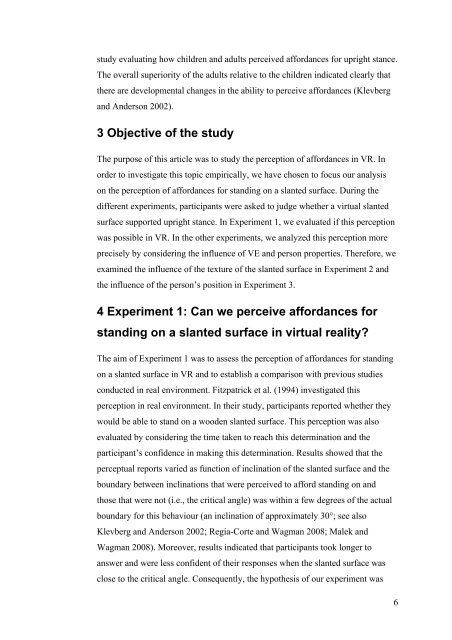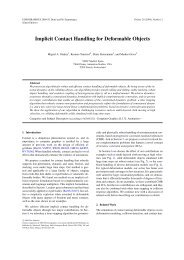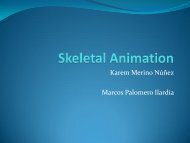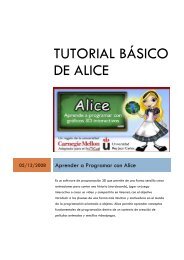Perceiving affordances in virtual reality: Influence of person ... - GMRV
Perceiving affordances in virtual reality: Influence of person ... - GMRV
Perceiving affordances in virtual reality: Influence of person ... - GMRV
Create successful ePaper yourself
Turn your PDF publications into a flip-book with our unique Google optimized e-Paper software.
study evaluat<strong>in</strong>g how children and adults perceived <strong>affordances</strong> for upright stance.<br />
The overall superiority <strong>of</strong> the adults relative to the children <strong>in</strong>dicated clearly that<br />
there are developmental changes <strong>in</strong> the ability to perceive <strong>affordances</strong> (Klevberg<br />
and Anderson 2002).<br />
3 Objective <strong>of</strong> the study<br />
The purpose <strong>of</strong> this article was to study the perception <strong>of</strong> <strong>affordances</strong> <strong>in</strong> VR. In<br />
order to <strong>in</strong>vestigate this topic empirically, we have chosen to focus our analysis<br />
on the perception <strong>of</strong> <strong>affordances</strong> for stand<strong>in</strong>g on a slanted surface. Dur<strong>in</strong>g the<br />
different experiments, participants were asked to judge whether a <strong>virtual</strong> slanted<br />
surface supported upright stance. In Experiment 1, we evaluated if this perception<br />
was possible <strong>in</strong> VR. In the other experiments, we analyzed this perception more<br />
precisely by consider<strong>in</strong>g the <strong>in</strong>fluence <strong>of</strong> VE and <strong>person</strong> properties. Therefore, we<br />
exam<strong>in</strong>ed the <strong>in</strong>fluence <strong>of</strong> the texture <strong>of</strong> the slanted surface <strong>in</strong> Experiment 2 and<br />
the <strong>in</strong>fluence <strong>of</strong> the <strong>person</strong>’s position <strong>in</strong> Experiment 3.<br />
4 Experiment 1: Can we perceive <strong>affordances</strong> for<br />
stand<strong>in</strong>g on a slanted surface <strong>in</strong> <strong>virtual</strong> <strong>reality</strong><br />
The aim <strong>of</strong> Experiment 1 was to assess the perception <strong>of</strong> <strong>affordances</strong> for stand<strong>in</strong>g<br />
on a slanted surface <strong>in</strong> VR and to establish a comparison with previous studies<br />
conducted <strong>in</strong> real environment. Fitzpatrick et al. (1994) <strong>in</strong>vestigated this<br />
perception <strong>in</strong> real environment. In their study, participants reported whether they<br />
would be able to stand on a wooden slanted surface. This perception was also<br />
evaluated by consider<strong>in</strong>g the time taken to reach this determ<strong>in</strong>ation and the<br />
participant’s confidence <strong>in</strong> mak<strong>in</strong>g this determ<strong>in</strong>ation. Results showed that the<br />
perceptual reports varied as function <strong>of</strong> <strong>in</strong>cl<strong>in</strong>ation <strong>of</strong> the slanted surface and the<br />
boundary between <strong>in</strong>cl<strong>in</strong>ations that were perceived to afford stand<strong>in</strong>g on and<br />
those that were not (i.e., the critical angle) was with<strong>in</strong> a few degrees <strong>of</strong> the actual<br />
boundary for this behaviour (an <strong>in</strong>cl<strong>in</strong>ation <strong>of</strong> approximately 30°; see also<br />
Klevberg and Anderson 2002; Regia-Corte and Wagman 2008; Malek and<br />
Wagman 2008). Moreover, results <strong>in</strong>dicated that participants took longer to<br />
answer and were less confident <strong>of</strong> their responses when the slanted surface was<br />
close to the critical angle. Consequently, the hypothesis <strong>of</strong> our experiment was<br />
6





